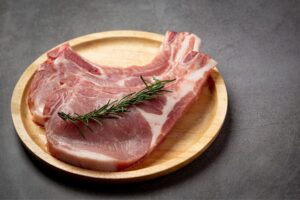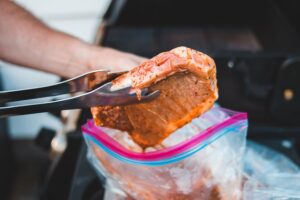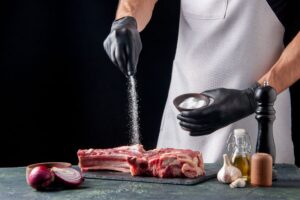Greetings from the flavorful land of pork, where mouthwatering meals can be a culinary delight. But there could be a problem: boar taint.

You are not alone if you have ever wondered why your pork sometimes smells terrible. We will solve the puzzles surrounding boar taint in this guide and provide valuable tips for eliminating it from your kitchen.
Take a culinary adventure with us, regardless of your experience level, and learn the tricks to cooking pork that tastes great and leaves no unpleasant aftertaste.
Together, let us improve your pork cooking abilities to new levels!
What Is Boar Taint?
The pleasure of cooking with pork can be overshadowed by the elusive culinary challenge known as boar taint. To clarify this phenomenon, let us first define it.
Boar taint is an unpleasant taste and smell that occasionally appears in pork and is caused by substances that naturally occur in male pigs. While not harmful, it can detract from the dining experience.
What Causes Boar Taint?
Boar taint is primarily influenced by two compounds: androstenone and skatole.
Androstenone, responsible for the unpleasant odor, is produced in the testes, while skatole, contributing to the flavor, originates in the pig’s digestive system.
Factors such as genetics, diet, and the age of the boar play significant roles in determining the intensity of boar taint.
How to Identify Boar Taint
It is critical to identify boar taint before cooking. Pork that has been contaminated may smell musky, fecal, or urine-like, and its flavor may be bitter or gamey.
Luckily, we can eliminate boar taint by knowing where it came from, so every pork dish will taste delicious.
Choosing the Right Cuts
Now that we’ve unveiled the secrets of boar taint let’s delve into the practical steps you can take to ensure your pork dishes are consistently delicious. It starts with choosing the right cuts.
Embrace Variety
Pork offers a myriad of cuts, each with its unique characteristics. To minimize the risk of encountering boar taint, opt for cuts that are less prone to retaining these unwanted flavors.
Consider pork loin, tenderloin, or chops from reputable sources, as these cuts are generally less affected by boar taint.
The Art of Selection
When perusing the meat aisle, pay attention to the color and marbling of the pork. Fresh, high-quality pork tends to have a pinkish hue and moderate marbling.
If you need more clarification, feel free to ask your local butcher for advice on the best cuts available.
Tips for Success
Choose Female or Castrated Male Pork: Female pigs and castrated males are less likely to exhibit boar taint, making them safer choices for your culinary adventures.
Explore Specialty Butchers: Specialty butchers often provide carefully sourced pork focusing on quality and flavor. Consider exploring local butcher shops for a personalized and expert touch.
By choosing your pork carefully, you are laying the groundwork for a tasty meal free of boar taint. We will look at some cooking methods in the following section that will bring out the flavors of your selected cuts even more.
Cooking Techniques to Minimize Boar Taint
Preparing and Marinating for Success
Now that you’ve carefully chosen the right pork cuts, let’s dive into the art of preparation and marination to ensure your dishes are not only succulent but also free from any lingering boar taint.

1. The Magic of Marinades
Marinades serve as potent allies in masking and enhancing the flavor of your pork. Ingredients like citrus juices, herbs, and spices not only infuse delightful tastes but also work to neutralize any potential boar taint.
Allow your pork to bathe in these flavorful concoctions for an extended period before cooking to achieve the best results.
2. Recommended Marinade Ingredients
Citrus Juices: Lemon, lime, or orange juices can add a refreshing zing and help counteract any lingering taint.
Herbs: Rosemary, thyme, and sage contribute aromatic notes that complement the natural flavors of pork.
Spices: Garlic, ginger, and black pepper bring depth and complexity to your marinade.
Cooking Temperatures and Times
Careful consideration of cooking temperatures and times is crucial to minimizing boar taint. Aim for thorough cooking without overdoing it, as excessive heat can intensify the taint.
Use a meat thermometer to ensure your pork reaches the recommended internal temperature for safety while preserving optimal flavor.
Grilling, Roasting, and Slow Cooking
Experimenting with various cooking methods can further elevate your pork dishes. Grilling imparts a smoky flavor, roasting locks in juices, and slow cooking allows flavors to meld harmoniously.
Tailor your cooking method to suit the cut, and don’t be afraid to explore different techniques to find what works best for you.
Flavorful Seasonings and Ingredients
Elevating Taste to Mask Boar Taint
Now that we’ve covered the fundamentals of preparation and cooking, let’s turn our attention to the palate-pleasing world of seasonings and ingredients.
By carefully selecting complementary flavors, you can ensure your pork dishes not only delight the taste buds but also effectively conceal any potential boar taint.
1. Seasonings that Complement Pork
Salt and Pepper: The classic duo enhances the natural flavors of pork without overpowering them. Use them judiciously to achieve a well-balanced taste.
Paprika: This versatile spice adds a mild, slightly sweet flavor and a beautiful reddish hue to your pork dishes.
Cumin: Known for its warm and earthy notes, cumin pairs exceptionally well with pork, adding depth to the overall taste.
2. Herbs and Spices for Depth
Rosemary: With its pine-like aroma, rosemary brings a touch of sophistication to pork dishes, masking any undesirable odors.
Garlic and Onion: These aromatic staples not only infuse your dishes with rich flavor but also contribute to masking boar taint effectively.
3. Combining Flavors Creatively
Experiment with combining various herbs, spices, and seasonings to create your unique flavor profiles.
Consider creating spice rubs or herb-infused oils to add an extra layer of complexity to your pork dishes.
The key is to strike a balance that enhances the pork’s natural taste while effectively camouflaging any traces of boar taint.
Pro Tips From Chefs and Experienced Cooks
Insights from the Masters
Embarking on a culinary journey to conquer boar taint? Let’s gain some wisdom from seasoned chefs and experienced home cooks who have mastered the art of preparing delectable pork dishes.

1. The Power of Brining
Chef’s Tip: Consider brining your pork before cooking. A simple solution of water, salt, and sugar can do wonders in enhancing the pork’s juiciness while minimizing any lingering taint.
2. Play with Sweet and Savory Combinations
Home Cook’s Secret: Experiment with sweet and savory flavor combinations. Brown sugar, honey, or fruit-based glazes can counteract any unwanted taste, providing a delightful contrast.
3. Blend High and Low Heat
Chef’s Insight: Employ a combination of high and low heat during cooking.
Searing your pork at a high temperature initially can lock in flavors, while slow cooking ensures a tender and fully cooked result without intensifying the taint.
4. Wine as a Marinade
Home Cook’s Recommendation: Use wine-based marinades to infuse your pork with additional complexity. The acidity in wine can help neutralize undesirable flavors, resulting in a more refined taste.
5. Embrace Aromatics
Chef’s Advice: Utilize aromatic vegetables such as celery, carrots, and leeks during the cooking process. These ingredients not only contribute to the overall flavor profile but also work harmoniously to mask any potential boar taint.
6. Rest and Let the Flavors Mingle
Home Cook’s Wisdom: Allow your cooked pork to rest before serving. This crucial step allows the flavors to meld, creating a harmonious taste that diminishes any lingering taint.
Conclusion
You have started a tasty adventure to overcome boar taint and improve your pork cooking abilities.
Now that you know why boar taint occurs, how to choose the best cuts, and professional advice on marinades, seasonings, and cooking methods, you can make mouthwatering pork dishes that will delight the senses.
Remember, the key lies in a thoughtful combination of preparation, cooking methods, and seasoning choices.
Whether you’re a culinary enthusiast experimenting in your kitchen or a seasoned chef looking to refine your craft, the art of cooking pork without boar taint is within your reach.
As you continue to explore the diverse world of flavors and techniques, don’t be afraid to innovate and personalize these strategies. Your kitchen is your creative space, and the joy of cooking lies in the journey of discovery.
So go ahead, savor the moments, and relish the delicious, boar taint-free pork creations you’re about to unleash on your dining table. Happy cooking!
